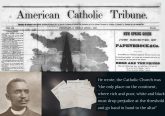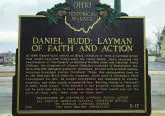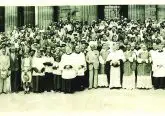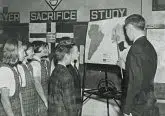AOC Bicentennial: the society of mary in dayton
Dayton was surveyed and platted in 1796. Following the War of 1812 and the completion of the Miami and Erie Canals in 1829, Dayton began to thrive. Emmanuel Parish established the first Catholic Church in Dayton in 1837. As with many churches in “mission” territory, it served as a base for priests who traveled to administer the sacraments in surrounding areas.
Two members of the Society of Mary (Marianists), Father Leo Meyer and Brother Charles Schultz, arrived in Cincinnati in 1849 to assist Bishop John Purcell. They then traveled to Emmanuel Church in Dayton to aid with the cholera outbreak.
While there, Father Meyer met John Stuart, who agreed to sell his 120-acre farm to Father Meyer for the purpose of building a school. In the summer of 1850, 14 boys began lessons at the new school with four Marianists serving as faculty, cook and
farmer. First called Nazareth, its name was later changed to St. Mary’s School for Boys, and then to St. Mary’s Institute.
The Institute grew alongside the city of Dayton. Brother Maximin Zehler became the school’s third president in 1860; and under his management it grew exponentially. A novitiate was established in 1864 to form new vocations for the Marianists.
The campus’ large chapel was dedicated in 1869. It still stands today at the heart of the University of Dayton campus. The niches outside the chapel contain two statues: Blessed William Chaminade (the Marianists’ founder) and Our Lady of the Pillar, to whom Chaminade held a deep devotion.
While the Institute was initially the primary ministry of the Marianists, they also taught at parochial schools in Cincinnati and Dayton. Additionally, the Institute housed elementary and secondary schools, but they were eventually phased out. In 1912, the school received state accreditation and changed its name to St. Mary’s College. In 1920, the name was again changed to the University of Dayton.
One of the biggest natural disasters in Ohio history came at Eastertime in 1913. Unprecedented rains in March caused the Great Miami River and surrounding waterways to flood. Water in downtown Dayton reached 20 feet. Due to its location, St. Mary’s College was untouched by the disaster. And although the Marianists were on retreat when the flooding began, they hurried back to lead relief efforts and worked in conjunction with the city of Dayton to provide resources to those in need. They opened the college’s dormitories for housing, food and clothing to 700 people who lost their homes in the flood.
The school continued to grow and expand in the 20th Century, with a goal to be “Dayton’s University.” Summer classes were added to the schedule in 1923, and women were admitted to the university for the first time. In 1943, the university founded the Marian Library. This world-renowned library provides extensive resources on the Blessed Virgin Mary. The library houses exhibit space, including displays of their popular collection of 3,600 crèches from around the world.
Today the University of Dayton continues the charism of the Marianists to be called by God and formed by the Blessed Virgin, and thus go out and spread the Good News in the community. In the U.S., the Marianists are now one province and serve in parishes, secondary schools, universities and retreat centers.
This article appeared in the May 2021 edition of The Catholic Telegraph Magazine. For your complimentary subscription, click here.















